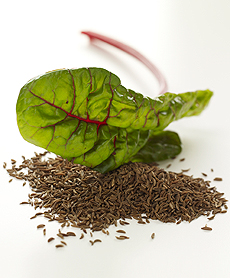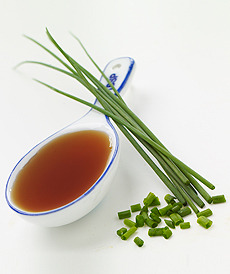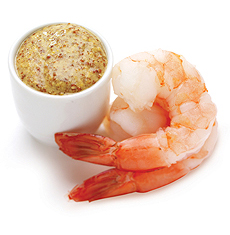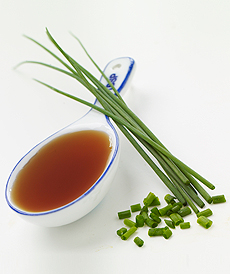Flavor Trends 2010
Page 2: Cook Up A New Food Trend With
-
Caraway & Bitter Greens
-
Chives & Fish Sauce
-
Creole Mustard & Shellfish
This is Page 2 of a four page article, plus 10 pages of recipes, on McCormick’s flavor trends for 2010. Click on the black links below to view all 10 flavor pairings.
Pairing 3: Caraway & Bitter Greens

Caraway seeds are actually a fruit, not a seed. The caraway plant looks similar to a carrot plant, with feathery leaves and thread-like divisions. The “seeds” are small, crescent-shaped achenes (an achene is a one-seeded fruit; the seed has a thin wall, such as a sunflower seed). Caraway seeds have a licorice-like flavor and are frequently used in rye breads, crackers, cheeses and liqueurs. (We love to mix them into sauerkraut, too.)
“Bitter greens” refers to a variety of dark green, leafy vegetables, including spinach, collards, chard and kale. The name “bitter greens” is no misnomer. When cooked, these veggies have a distinctive (and desirable) bitter flavor that juxtaposes well against other strong flavors. Examples include collards cooked with bacon or spinach salad topped with a sweet lemon poppyseed dressing.
Try this recipe for Grilled Bitter Greens with Caraway Peach Dressing, in which the unmistakable caraway spice tames the bitter bite of bold greens.
By the way, caraway was also an early candy, dating back to at least the 17th century. Tiny seeds coated with many layers of sugar were a popular confection known as a comfit (not confit). The original sugarplums were sugar-coated coriander (the seeds of cilantro); aniseed and caraway were other popular comfits.
Pairing 4: Chives & Fish Sauce
 Chives are the smallest member of the onion family. The part used for culinary dishes is the thin, hollow, tubular leaves that resemble large stalks of grass. Mild in flavor, chives are used in a multitude of dishes, including dips, potatoes, fish and eggs, and is especially prevalent in French cuisine. Chives are also a lovely garnish, whole or chopped. Chives are the smallest member of the onion family. The part used for culinary dishes is the thin, hollow, tubular leaves that resemble large stalks of grass. Mild in flavor, chives are used in a multitude of dishes, including dips, potatoes, fish and eggs, and is especially prevalent in French cuisine. Chives are also a lovely garnish, whole or chopped.
Fish sauce is an Asian condiment derived from fermented fish. If that sounds odd, that’s what Worcestershire sauce is; and the ancient Romans’ favorite condiment was a fermented fish sauce called garum.
Different countries have their own ways of preparing the sauce, but anchovies are used most often (in Worcestershire sauce, garum, the nam pla of Thailand and Vietnam, and others); some nations or regions use shellfish (for example, belachan, or shrimp paste, in Malaysia), squid or other small fish. (The flavor is usually quite strong, so only a small amount is required for most dishes. Fish sauce can be purchased in Asian grocery stores or the Asian section of most supermarkets.
Recipe: Try this “Deconstructed” Spring Roll Salad With Pork Hors D’Oeuvres, and taste the fusion of French and Asian cuisine. You can enjoy the chive and fish sauce dressing on many other recipes, too.
Pairing 5: Creole Mustard & Shellfish
 Creole mustard is a staple in New Orleans cuisine. It is grainier in appearance and tastes tangier than other mustards due to its higher concentration of brown mustard seeds. (Today, some products labeled “Creole mustard” are sweet-style mustards made with molasses. Check the label before purchasing. See our Mustard Glossary for more information on the many types of mustard.) Creole mustard is a staple in New Orleans cuisine. It is grainier in appearance and tastes tangier than other mustards due to its higher concentration of brown mustard seeds. (Today, some products labeled “Creole mustard” are sweet-style mustards made with molasses. Check the label before purchasing. See our Mustard Glossary for more information on the many types of mustard.)
Creole mustard can be used as a sandwich condiment, a marinade for meat, a dip and incorporated into seafood dishes.
Seafood is often served with a sauce or dip that has a bit of pungency or heat (think horseradish in cocktail sauce). Creole mustard is especially tasty when used as the base for Creole-style rémoulade sauce, a perfect accent to fried fish, or incorporated into breaded seafood dishes such as crab cakes or fishburgers.
Recipe: Try this classic southern recipe for Fried Green Tomatoes with Crab & Creole Mustard. And whip up a Creole mustard dip in addition to/instead of a tomato-based cocktail sauce for your next shrimp cocktail or raw bar. (Use your favorite dip base—fat free yogurt, mayonnaise, sour cream, etc., or a combination. Add mustard to taste along with a complementary fresh herb—chives, thyme, etc.)
Continue To Page 3: Pumpkin Pie Spice & Coconut Milk And Others
Go To The Article Index Above
All materials

|






 Chives
Chives C
C